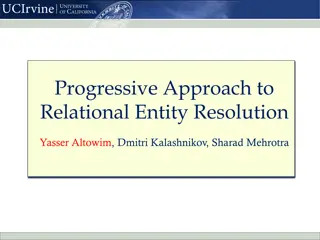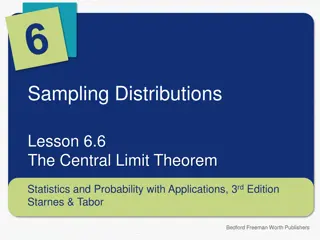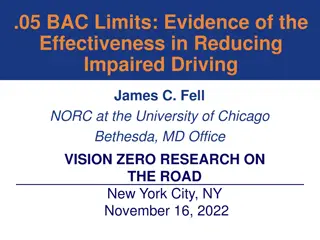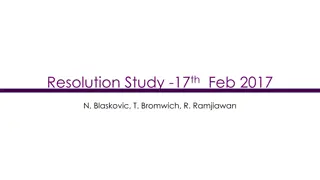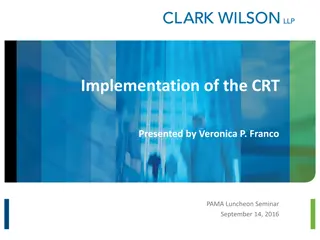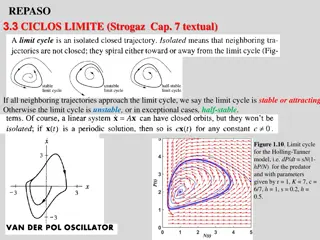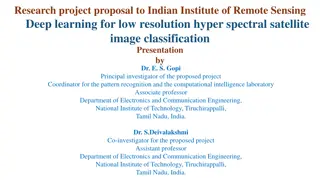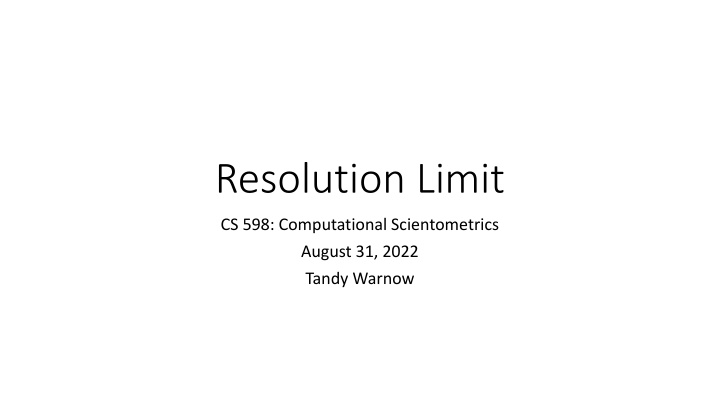
Modularity Optimization and Resolution Limit in Computational Scientometrics
Explore the concept of modularity optimization in computational scientometrics, focusing on the resolution limit discussed by Fortunato & Barthélemy. Learn how optimizing modularity aims to maximize clusters' modularity scores but may face limitations in detecting small modules. The discussion delves into the criteria for defining actual modules based on positive modularity scores. Discover the implications of this resolution limit and its significance in network analysis.
Download Presentation

Please find below an Image/Link to download the presentation.
The content on the website is provided AS IS for your information and personal use only. It may not be sold, licensed, or shared on other websites without obtaining consent from the author. If you encounter any issues during the download, it is possible that the publisher has removed the file from their server.
You are allowed to download the files provided on this website for personal or commercial use, subject to the condition that they are used lawfully. All files are the property of their respective owners.
The content on the website is provided AS IS for your information and personal use only. It may not be sold, licensed, or shared on other websites without obtaining consent from the author.
E N D
Presentation Transcript
Resolution Limit CS 598: Computational Scientometrics August 31, 2022 Tandy Warnow
Assigned papers https://www.pnas.org/doi/full/10.1073/pnas.0605965104. Fortunato & Barth lemy, PNAS 2007, Resolution limit in community detection Henceforth, I ll refer to this as F&B
Modularity optimization Modularity optimization seeks a partition of the vertices into disjoint sets (i.e., clusters) so that the sum of the modularity scores of each cluster is maximized Any cluster/module with positive modularity is considered actual (equivalently, real, valid, etc.) F&B (Fortunato and Barth lemy) proved that optimizing modularity has a resolution limit modules below a threshold will not be found. See https://en.wikipedia.org/wiki/Modularity_(networks) for additional references.
Modularity optimization Partition the graph vertices into m disjoint sets, so as to maximize the sum of the modularity scores per cluster Assume the clustering has m clusters: L = total number of edges in network ls = number of edges in cluster s ds = total degree of nodes in cluster s (including edges that leave cluster)
F&B discussion F&B discussion Page 1: The first term of the summand in Eq. 1 is the fraction of links inside module s; the second term, in contrast, represents theexpected fraction of links in that module, if links were located atrandom in the network (under the only constraint that the degreesequence coincides with the one of the original graph).
F&B discussion F&B discussion Page 2: (Paraphrasing) We conclude that, in a modularity-based framework, a subgraph is a module if <its modularity score is positive>
Fortunato & Barth lemy Basic observation is that Modularity Optimization is subject to a resolution limit (will not find small actual modules ) For them, actual simply means positive modularity score Figure 3(A) from Fortunato & Barth lemy
Modularity score L = total number of edges in network ls = number of edges in cluster s ds = total degree of nodes in cluster s (including edges that leave cluster) Warm-up for calculating modularity scores of single clusters (i.e., calculating modularity(C)). Assume all networks have at least one edge, so L > 0. 1. What is the modularity score of a cluster containing a single isolated node in the network? 2. What is the modularity score of a cluster that has no internal edges? 3. Assuming that the network has more than one non-trivial component (at least one edge), what is the modularity score of a connected component in the network? 4. What is the modularity score of the cluster containing the entire network? 5. Suppose a network N has at least two non-trivial components and then many isolated vertices. a. What is the modularity score of the cluster containing all the isolated vertices? b. Suppose C is a cluster, and you add some isolated vertices to get C ; what can you say about modularity(C) vs modularity(C )?
Modularity score L = total number of edges in network ls = number of edges in cluster s ds = total degree of nodes in cluster s (including edges that leave cluster) Test cases: 1. Network has two disjoint cliques (Kn and Km) that have no edges between them. For each clique, what is the modularity score? 2. Network has same two disjoint cliques with an edge between them. For each clique, what is the modularity score? 3. Network is just Kn (with n>3). What is the modularity score of a K3 inside the network? 4. Network is complete bipartite graph Kn,m, and n<m. What is the modularity score of the LHS? The RHS? Can you find any cluster with positive modularity?
Modularity score L = total number of edges in network ls = number of edges in cluster s ds = total degree of nodes in cluster s (including edges that leave cluster) Test cases: For each network and each suggested clustering, calculate the modularity score. 1. Network has two disjoint cliques (Kn and Km), n<m, that have no edges between them. Clustering: the two cliques 2. Network has same two disjoint cliques with an edge between them. Clustering: the two cliques 3. Network has same two disjoint cliques with all nodes in Kn adjacent to the same single node x in Km. Clustering: the two cliques What if n>m?
Back to F&B Assumption (or assertion?): all clusters with positive modularity are modules . Figure 1 from R&B (on the right) is a ring of cliques, connected by edges. Each clique has positive modularity. A natural clustering should return each of these clusters.
Digging down into F&B analysis They assume that the network N is connected, and is a ring of n>2 clusters, connected by single edges. All clusters are cliques Km with m edges. Note: all these clusters have positive modularity. They prove Q pairs > Q single when n > m(m-1)+2. This statement is equivalent to saying the clustering that merges adjacent pairs of cliques has modularity that is higher than the obvious (natural) clustering. Put differently, they prove that clusters that are too small cannot be found in this network for large enough n. Hence, an infinite set of networks, for which optimizing modularity will not return the natural clustering.
Closing paragraph in F&B The fact that quality functions such as modularity can have an intrinsic resolution limit calls for a new theoretical frameworkthat focuses on a local definition of community, rather than ondefinitions relying on a global null model. Quality functions arestill helpful, but their role should probably be limited to thecomparison of partitions with the same number of modules.
Further comments (related to Scientometrics) In Scientometrics, the main clustering method is the Leiden algorithm, optimized either for modularity or the Constant Potts model Modularity was favored before the resolution limit issue was understood tends to produce large clusters Now Constant Potts model is default setting (not subject to resolution limit)
Summary from today The resolution limit is a theoretical problem (limit to how small a community can be found) but may provide insight into practice In other words, if your clustering method produces large clusters and doesn t find smaller clusters, perhaps it is has a resolution limit. Find out. Consider developing new clustering optimization problems.
Starting 9/7: Distinguished Guest Speakers Important: Read their papers (see webpage) before coming to the class and be prepared to ask questions. For example, meet together (or use slack) to discuss their assigned papers. 9/7: Henry Small (Three papers: Shoulders of Giants, Co-citation, and Bayesian conformation) 9/12: Dan Gusfield (click on link for Dan Gusfield to get assigned papers) 9/14: Vincent Traag 9/19: Daniel Hook & Simon Porter 9/21: David Sepkoski 9/28: Kevin Boyack 10/3: Martina Iori 10/5: Srijan Sengupta
Henry Small (speaking Sept 7): papers to read Henry Small (speaking Sept 7): papers to read Co-citation in the scientific literature: A new measure of the relationship between two documents. https://asistdl.onlinelibrary.wiley.com/doi/10.1002/asi.4630240406 ASIS Award of Merit: On the Shoulders of Giants. https://asistdl.onlinelibrary.wiley.com/doi/pdf/10.1002/bult.112 The confirmation of scientific theories using Bayesian causal networks and citation sentiments. https://direct.mit.edu/qss/article/3/2/393/110636/The-confirmation- of-scientific-theories-using

